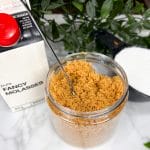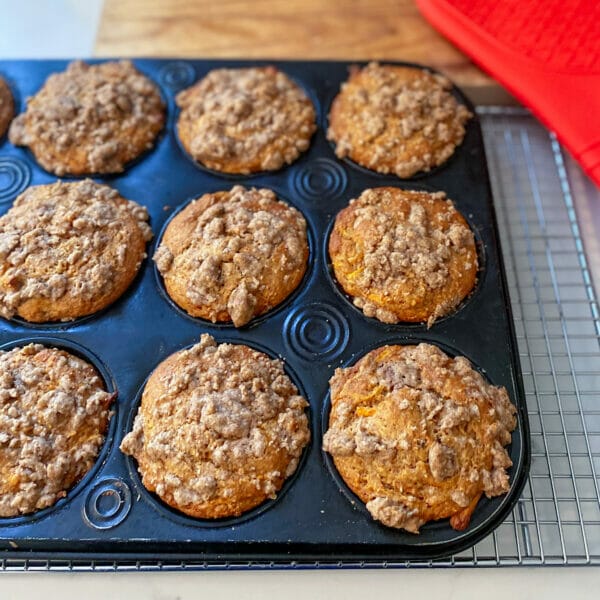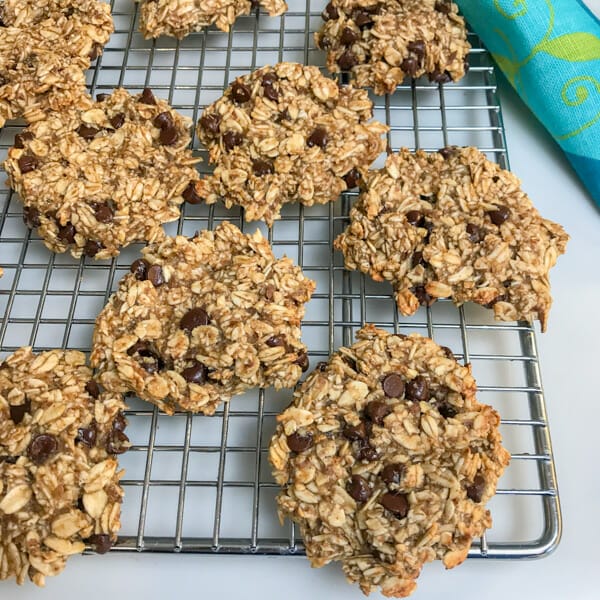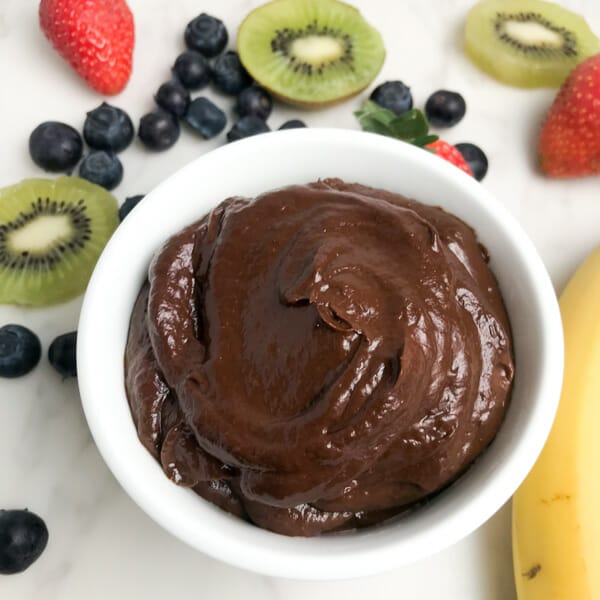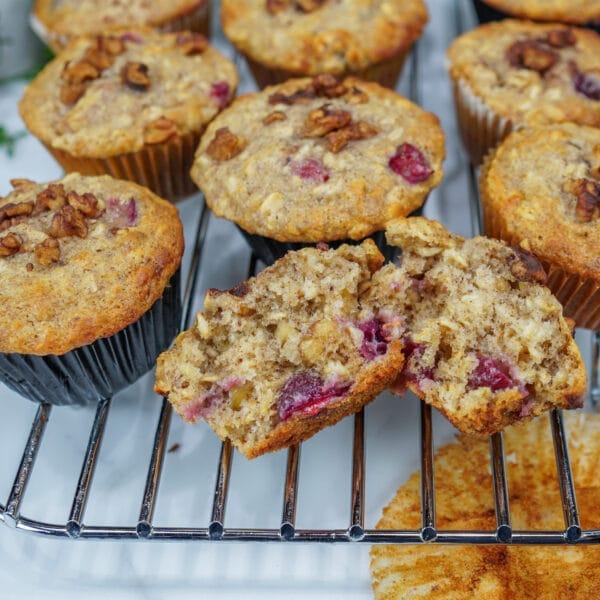How to Make Brown Sugar and Sugar Substitutes in Baking
Make homemade brown sugar with molasses and granulated white sugar. This quick recipe will save you a trip to the store if you run out of brown sugar mid-bake. Looking for more sugar substitutes in baking? Here are four more sugar alternatives you can using in your favorite recipes. Whether you are low on granulated sugar or want to try a different flavor or texture in your baking, here are the sugar substitution ratios you need to replace sugar in baking.
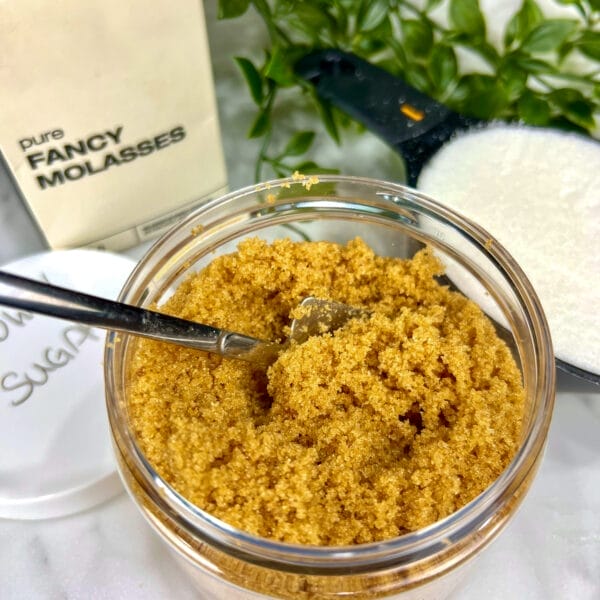
Read more: Carrot Applesauce Muffins, Banana Choco Chip Oat Cookies, Chocolate Avocado Banana Pudding/Dip
What is Sugar used for in Baking?
Before we swap out any of our sugars, it’s important to understand the multiple roles that sugar plays in baking. Sugar not only sweetens our favorite treats but also contributes to texture, tenderness, color, and moisture retention. It aids in leavening, provides structure, and enhances flavor. All factors we need to consider before adapting our recipes.
- sweet flavor
- adds texture & moisture
- food for yeast
- adds structure and volume
- aerates butter when creaming
- adds structure to whipped egg whites
- caramelizes to provide color
- provides gooey stickiness (mmm, sticky buns!)
- thickens fillings and frostings
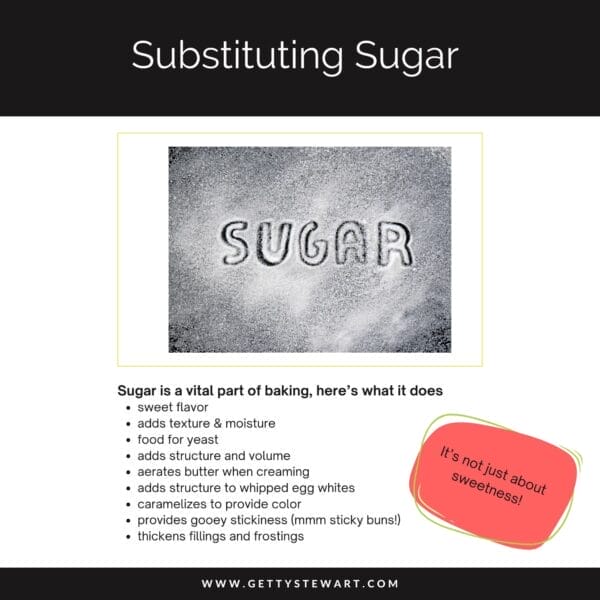
Recipe: Make your own Brown Sugar
How to Make Brown Sugar
Ingredients
- 1 cup granulated sugar
- 1-3 Tbsp molasses
Instructions
- In a bowl combine sugar with 1 tablespoon molasses, stir vigorously (or use a hand blender) to thoroughly mix the sugar and molasses until it looks like brown sugar.
- Add more molasses as desired to make darker brown sugar.
- Store in an airtight container and keep like you would store bought brown sugar.
Video
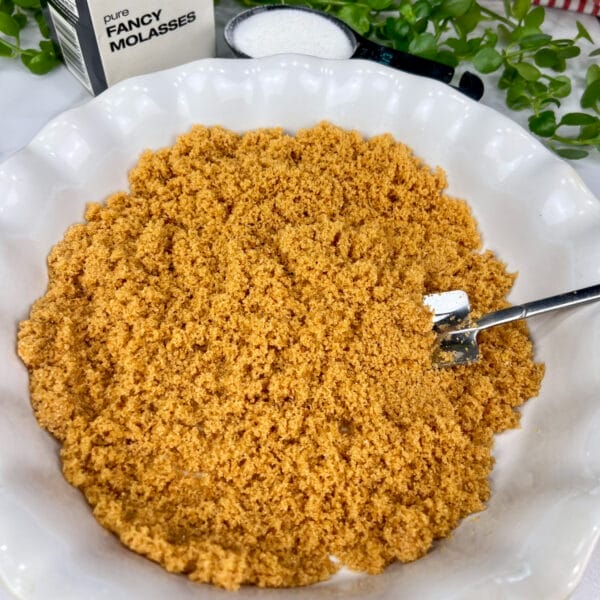
4 Ways to Replace Granulated Sugar in Baking
Certain types of baking are more adaptable to sugar substitutes than others. That means, be strategic with your sugar. Save whatever sugar you can get your hands on, for recipes that you cherish the most and are the least flexible. Quick breads, muffins, and cookies are quite easy to modify while others like delicate cakes, meringues and royal icing are not as forgiving.
The following are some ways to substitute sugar in baking recipes with the easiest being simply swapping out the type of sugar. The others require a little more experimenting but can produce very tasty results.
1. Substitute the Type of Sugar
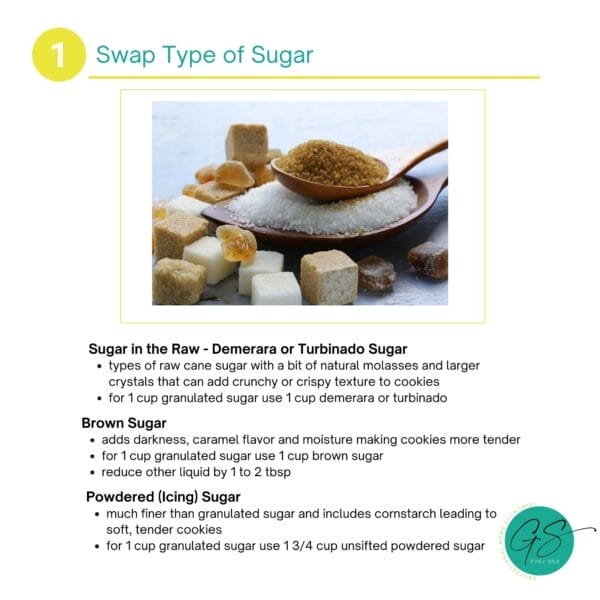
- Sugar in the Raw (Demerara or Turbinado Sugar): Adds natural molasses and larger crystals, offering a crunchy texture. Use 1 cup demerara or turbinado for 1 cup granulated sugar.
- Brown Sugar: Adds darkness, caramel flavor, and moisture, making cookies more tender. Use 1 cup brown sugar for 1 cup granulated sugar; reduce other liquids by 1 to 2 tbsp.
- Powdered (Icing) Sugar: Finer than granulated sugar, includes cornstarch for soft, tender cookies. Use 1 3/4 cup unsifted powdered sugar for 1 cup granulated sugar.
2. Use Liquid Sweeteners instead of Sugar in Baking
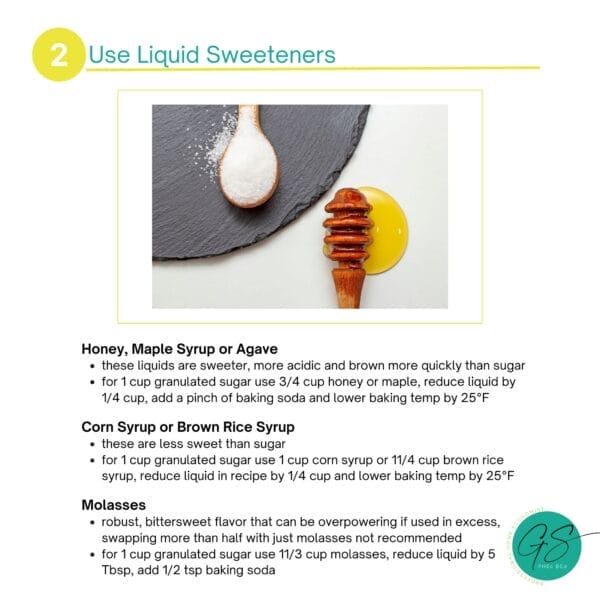
- Honey, Maple Syrup, or Agave: Sweeter, more acidic, and brown more quickly than sugar. Use 3/4 cup honey or maple syrup for 1 cup granulated sugar; reduce liquid by 1/4 cup, add a pinch of baking soda, and lower baking temp by 25°F.
- Corn Syrup or Brown Rice Syrup: Less sweet than sugar. Use 1 cup corn syrup or 1 1/4 cup brown rice syrup for 1 cup granulated sugar; reduce liquid by 1/4 cup and lower baking temp by 25°F.
- Molasses: Robust, bittersweet flavor. Use 1 1/3 cup molasses for 1 cup granulated sugar; reduce liquid by 5 tbsp, add 1/2 tsp baking soda. Replacing more than half the sugar amount with molasses is not recommended, use in combination with other sweeteners.
3. Use Fruit Purée in Baking instead of Sugar

- Best for quick breads, muffins, pancakes, and some drop cookies and when used in combination with other sweeteners.
- Mashed Banana (overripe): Mash well; use 1/2 cup mashed banana for 1 cup sugar and reduce liquid in the recipe.
- Applesauce: Use 3/4 cup applesauce for 1 cup sugar and reduce liquid in the recipe.
4. Replace Sugar with Artificial or Alternative Sweeteners in Baking
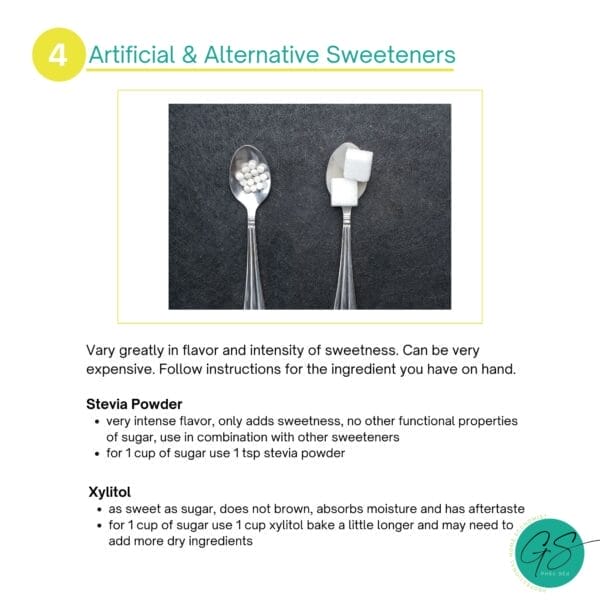
- There are many types of artificial sweeteners that vary greatly in flavor, intensity of sweetness and function. Some are easily substituted for sugar and some are not recommended for baking, follow instructions on package.
- Stevia Powder/Liquid: Very intense flavor, adds only sweetness, no other functions of sugar. Use 1 tsp stevia powder or 2 to 3 stevia drops for 1 cup of sugar and 1/3 cup of apple sauce, pumpkin purée or yogurt for bulk.
- Xylitol: Looks similar to sugar and is as sweet as sugar but does have a distinct flavour. It does not cause browning and absorbs moisture. Use 1 cup xylitol for 1 cup sugar; bake a little longer for some browning.
When making substitutions like these expect the final texture and flavour to be slightly different from the original. Accept and enjoy these differences and take the opportunity to reflect on how resourceful our great grandmothers had to be all the time.
How to Store Sugar
Store sugar in a cool, dry, odor free location. Sugar absorbs moisture and odor easily, so it’s best to transfer it to an airtight container. This is true for granulated sugar, brown sugar, confectioners or icing sugar and even coloured sparkly sugar, sprinkles and crushed candy canes.
Brown sugar contains moisture that needs to be locked in to prevent it from drying out. Use a tight fitting, airtight, rustproof container. Add a slice of apple, piece of bread or water-soaked clay disc to the container to ensure it stays nice and soft.
IMPORTANT: Do not freeze sugar as this will introduce moisture which leads to clumping.
How to Soften Hard Sugar
Sugar forms lumps or hardens into big blocks when moisture enters the container and then dries out. The moisture can be from water drops, steam or just humid air. Moisture causes sugar crystals to cling together and as the moisture dries out, the sugar becomes rock hard. Here’s how to break it apart
Physical Force: Try using a fork or rolling pin to crush the sugar back into order. You could also try pressing through a sieve or using a food processor. Although, when using anything with a blade, be careful not to pulverize the sugar into a powder.
Use Moisture & Heat: Reintroduce a tiny, itty bit of moisture with heat to soften the sugar. I like using the microwave for this.
Place a very slightly damp paper towel (I spray it with a mister) to cover the sugar in a microwaveable bowl. Place on high heat for one minute and use a fork to break up the sugar. If it is still too hard, microwave again as needed. It will become easy to break up with a fork. BUT this remedy only lasts until the moisture evaporates again, so only do the amount of sugar you need at one time as it may harden again.
Exact time will vary depending on how much sugar is in your bowl, how hard the sugar is and the strength of your microwave.
Recipes with Sugar Substitutes
Select, store and serve seasonal food for everyday cooking with Getty. Getty is a food educator and Professional Home Economist, who loves sharing tips and recipes following the seasons from her Canadian kitchen. Sign up to get seasonal tips and recipes delivered to your inbox. Learn more about Getty or check out her books and pdf guides.


